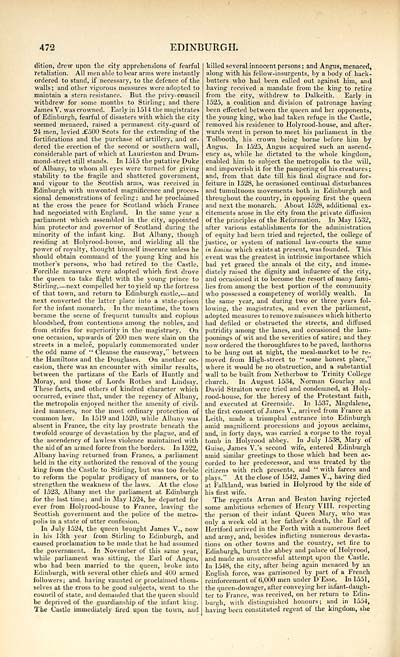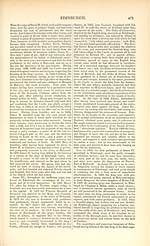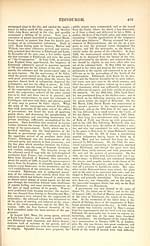Topographical, statistical, and historical gazetteer of Scotland > Volume 1
(564) Page 472 - EDI
Download files
Complete book:
Individual page:
Thumbnail gallery: Grid view | List view

472
EDINBURGH.
dition, drew upon the city apprehensions of fearful
retaliation. All men able to bear arms were instantly
ordered to stand, if necessary, to the defence of the
walls; and other vigorous measures were adopted to
maintain a stern resistance. But the privy-council
withdrew for some months to Stirling; and there
James V. was crowned. Early in 1514 the magistrates
of Edinburgh, fearful of disasters with which the city
seemed menaced, raised a permanent city-guard of
24 men, levied .£500 Scots for the extending of the
fortifications and the purchase of artillery, and or-
dered the erection of the second or southern wall,
considerable part of which at Laurieston and Drum-
mond-street still stands. In 1515 the putative Duke
of Albany, to whom all eyes were turned for giving
stability to the fragile and shattered government,
and vigour to the Scottish arms, was received in
Edinburgh with unwonted magnificence and proces-
sional demonstrations of feeling: and he proclaimed
at the cross the peace for Scotland which France
had negociated with England. In the same year a
parliament which assembled in the city, appointed
him protector and governor of Scotland during the
minority of the infant king. But Albany, though
residing at Holyrood-house, and wielding all the
power of royalty, thought himself insecure unless he
should obtain command of the young king and his
mother's persons, who had retired to the Castle.
Forcible measures were adopted which first drove
the queen to take flight with the young prince to
Stirling, — next compelled her to yield up the fortress
of that town, and return to Edinburgh castle,. — and
next converted the latter place into a state-prison
for the infant monarch. In the meantime, the town
became the scene of frequent tumults and copious
bloodshed, from contentions among the nobles, and
from strifes for superiority in the magistracy. On
one occasion, upwards of 200 men were slain on the
streets in a melee, popularly commemorated under
the odd name of " Cleanse the causeway," between
the Hamiltons and the Douglases. On another oc-
casion, there was an encounter with similar results,
between the partizans of the Earls of Huntly and
Moray, and those of Lords Rothes and Lindsay.
These facts, and others of kindred character which
•occurred, evince that, under the regency of Albany,
the metropolis enjoyed neither the amenity of civil-
ized manners, nor the most ordinary protection of
■common law. In 1519 and 1520, while Albany was
absent in France, the city lay prostrate beneath the
twofold scourge of devastation by the plague, and of
the ascendency of lawless violence maintained with
the aid of an armed force from the borders. In 1522,
Albany having returned from France, a parliament
held in the city authorized the removal of the young
king from the Castle to Stirling, but was too feeble
to reform the popular profligacy of manners, or to
strengthen the weakness of the laws. At the close
of 1523, Albany met the parliament at Edinburgh
for the last time: and in May 1524, he departed for
ever from Holyrood-house to France, leaving the
Scottish government and the police of the metro-
polis in a state of utter confusion.
In July 1524, the queen brought James V., now
in his 13th year from Stirling to Edinburgh, and
caused proclamation to be made that he had assumed
the government. In November of this same year,
while parliament was sitting, the Earl of Angus,
who had been married to the queen, broke into
Edinburgh, with several other chiefs and 400 armed
followers; and. having vaunted or proclaimed them-
selves at the cross to be good subjects, went to the
council of state, and demanded that the queen should
be deprived of the guardianship of the infant king.
The Castle immediately fired upon the town, and
killed several innocent persons; and Angus, menaced,
along with his fellow-insurgents, by a body of hack-
butters who had been called out against him, and
having received a mandate from the king to retire
from the city, withdrew to Dalkeith. Early in
1525, a coalition and division of patronage having
been effected between the queen and her opponents,
the young king, who had taken refuge in the Castle,
removed his residence to Holyrood-house, and after-
wards went in person to meet his parliament in the
Tolbooth, his crown being borne before him by
Angus. In 1525, Angus acquired such an ascend-
ency as, while he dictated to the whole kingdom,
enabled him to subject the metropolis to the will,
and impoverish it for the pampering of his creatures ;
and, from that date till his final disgrace and for-
feiture in 1528, he occasioned continual disturbances
and tumultuous movements both in Edinburgh and
throughout the country, in opposing first the queen
and next the monarch. About 1528, additional ex-
citements arose in the city from the private diffusion
of the principles of the Reformation. In May 1532,
after various establishments for the administration
of equity had been tried and rejected, the college of
justice, or system of national law-courts the same
in limine which exists at present, was founded. This
event was the greatest in intrinsic importance which
had yet graced the annals ol the city, and imme-
diately raised the dignity and influence of the city,
and occasioned it to become the resort of many fami-
lies from among the best portion of the community
who possessed a competency of worldly wealth. In
the same year, and during two or three years fol-
lowing, the magistrates, and even the parliament,
adopted measures to remove nuisances which hitherto
had defiled or obstructed the streets, and diffused
putridity among the lanes, and occasioned the lam-
poonings of wit and the severities of satire; and they
now ordered the thoroughfares to be paved, lanthorns
to be hung out at night, the meal-market to be re-
moved from High-street to " some honest place,"
where it would be no obstruction, and a substantial
wall to be built from Netherbow to Trinity College
church. In August 1534, Norman Gourlay and
David Straiton were tried and condemned, at Holy-
rood-house, for the heresy of the Protestant faith,
and executed at Greenside. In 1537, Magdalene,
the first consort of James V., arrived from France at
Leith, made a triumphal entrance into Edinburgh
amid magnificent processions and joyous acclaims,
and, in forty days, was carried a corpse to the royal
tomb in Holyrood abbey. In July 1538, Mary of
Guise, James V.'s second wife, entered Edinbiugh
amid similar greetings to those which had been ac-
corded to her predecessor, and was treated by the
citizens with rich presents, and " with farces and
plays." At the close of 1542, James V., having died
at Falkland, was buried in Holyrood by the side of
his first wife.
The regents Arran and Beaton having rejected
some ambitious schemes of Henry VIII. respecting
the person of their infant Queen Mary, who was
only a week old at her father's death, the Earl of
Hertford arrived in the Forth with a numerous fleet
and army, and, besides inflicting numerous devasta-
tions on other towns and the country, set fire to
Edinburgh, burnt the abbey and palace of Holyrood,
and made an unsuccessful attempt upon the Castle.
In 1548, the city, after being again menaced by an
English force, was garrisoned by part of a French
reinforcement of 6,000 men under D'Esse. In 1.551,
the queen-dowager, after conveying her infant-daugh-
ter to France, was received, on her return to Edin-
burgh, with distinguished honours; and in 1554,
having been constituted regent of the kingdom, she
EDINBURGH.
dition, drew upon the city apprehensions of fearful
retaliation. All men able to bear arms were instantly
ordered to stand, if necessary, to the defence of the
walls; and other vigorous measures were adopted to
maintain a stern resistance. But the privy-council
withdrew for some months to Stirling; and there
James V. was crowned. Early in 1514 the magistrates
of Edinburgh, fearful of disasters with which the city
seemed menaced, raised a permanent city-guard of
24 men, levied .£500 Scots for the extending of the
fortifications and the purchase of artillery, and or-
dered the erection of the second or southern wall,
considerable part of which at Laurieston and Drum-
mond-street still stands. In 1515 the putative Duke
of Albany, to whom all eyes were turned for giving
stability to the fragile and shattered government,
and vigour to the Scottish arms, was received in
Edinburgh with unwonted magnificence and proces-
sional demonstrations of feeling: and he proclaimed
at the cross the peace for Scotland which France
had negociated with England. In the same year a
parliament which assembled in the city, appointed
him protector and governor of Scotland during the
minority of the infant king. But Albany, though
residing at Holyrood-house, and wielding all the
power of royalty, thought himself insecure unless he
should obtain command of the young king and his
mother's persons, who had retired to the Castle.
Forcible measures were adopted which first drove
the queen to take flight with the young prince to
Stirling, — next compelled her to yield up the fortress
of that town, and return to Edinburgh castle,. — and
next converted the latter place into a state-prison
for the infant monarch. In the meantime, the town
became the scene of frequent tumults and copious
bloodshed, from contentions among the nobles, and
from strifes for superiority in the magistracy. On
one occasion, upwards of 200 men were slain on the
streets in a melee, popularly commemorated under
the odd name of " Cleanse the causeway," between
the Hamiltons and the Douglases. On another oc-
casion, there was an encounter with similar results,
between the partizans of the Earls of Huntly and
Moray, and those of Lords Rothes and Lindsay.
These facts, and others of kindred character which
•occurred, evince that, under the regency of Albany,
the metropolis enjoyed neither the amenity of civil-
ized manners, nor the most ordinary protection of
■common law. In 1519 and 1520, while Albany was
absent in France, the city lay prostrate beneath the
twofold scourge of devastation by the plague, and of
the ascendency of lawless violence maintained with
the aid of an armed force from the borders. In 1522,
Albany having returned from France, a parliament
held in the city authorized the removal of the young
king from the Castle to Stirling, but was too feeble
to reform the popular profligacy of manners, or to
strengthen the weakness of the laws. At the close
of 1523, Albany met the parliament at Edinburgh
for the last time: and in May 1524, he departed for
ever from Holyrood-house to France, leaving the
Scottish government and the police of the metro-
polis in a state of utter confusion.
In July 1524, the queen brought James V., now
in his 13th year from Stirling to Edinburgh, and
caused proclamation to be made that he had assumed
the government. In November of this same year,
while parliament was sitting, the Earl of Angus,
who had been married to the queen, broke into
Edinburgh, with several other chiefs and 400 armed
followers; and. having vaunted or proclaimed them-
selves at the cross to be good subjects, went to the
council of state, and demanded that the queen should
be deprived of the guardianship of the infant king.
The Castle immediately fired upon the town, and
killed several innocent persons; and Angus, menaced,
along with his fellow-insurgents, by a body of hack-
butters who had been called out against him, and
having received a mandate from the king to retire
from the city, withdrew to Dalkeith. Early in
1525, a coalition and division of patronage having
been effected between the queen and her opponents,
the young king, who had taken refuge in the Castle,
removed his residence to Holyrood-house, and after-
wards went in person to meet his parliament in the
Tolbooth, his crown being borne before him by
Angus. In 1525, Angus acquired such an ascend-
ency as, while he dictated to the whole kingdom,
enabled him to subject the metropolis to the will,
and impoverish it for the pampering of his creatures ;
and, from that date till his final disgrace and for-
feiture in 1528, he occasioned continual disturbances
and tumultuous movements both in Edinburgh and
throughout the country, in opposing first the queen
and next the monarch. About 1528, additional ex-
citements arose in the city from the private diffusion
of the principles of the Reformation. In May 1532,
after various establishments for the administration
of equity had been tried and rejected, the college of
justice, or system of national law-courts the same
in limine which exists at present, was founded. This
event was the greatest in intrinsic importance which
had yet graced the annals ol the city, and imme-
diately raised the dignity and influence of the city,
and occasioned it to become the resort of many fami-
lies from among the best portion of the community
who possessed a competency of worldly wealth. In
the same year, and during two or three years fol-
lowing, the magistrates, and even the parliament,
adopted measures to remove nuisances which hitherto
had defiled or obstructed the streets, and diffused
putridity among the lanes, and occasioned the lam-
poonings of wit and the severities of satire; and they
now ordered the thoroughfares to be paved, lanthorns
to be hung out at night, the meal-market to be re-
moved from High-street to " some honest place,"
where it would be no obstruction, and a substantial
wall to be built from Netherbow to Trinity College
church. In August 1534, Norman Gourlay and
David Straiton were tried and condemned, at Holy-
rood-house, for the heresy of the Protestant faith,
and executed at Greenside. In 1537, Magdalene,
the first consort of James V., arrived from France at
Leith, made a triumphal entrance into Edinburgh
amid magnificent processions and joyous acclaims,
and, in forty days, was carried a corpse to the royal
tomb in Holyrood abbey. In July 1538, Mary of
Guise, James V.'s second wife, entered Edinbiugh
amid similar greetings to those which had been ac-
corded to her predecessor, and was treated by the
citizens with rich presents, and " with farces and
plays." At the close of 1542, James V., having died
at Falkland, was buried in Holyrood by the side of
his first wife.
The regents Arran and Beaton having rejected
some ambitious schemes of Henry VIII. respecting
the person of their infant Queen Mary, who was
only a week old at her father's death, the Earl of
Hertford arrived in the Forth with a numerous fleet
and army, and, besides inflicting numerous devasta-
tions on other towns and the country, set fire to
Edinburgh, burnt the abbey and palace of Holyrood,
and made an unsuccessful attempt upon the Castle.
In 1548, the city, after being again menaced by an
English force, was garrisoned by part of a French
reinforcement of 6,000 men under D'Esse. In 1.551,
the queen-dowager, after conveying her infant-daugh-
ter to France, was received, on her return to Edin-
burgh, with distinguished honours; and in 1554,
having been constituted regent of the kingdom, she
Set display mode to: Large image | Transcription
Images and transcriptions on this page, including medium image downloads, may be used under the Creative Commons Attribution 4.0 International Licence unless otherwise stated. ![]()
| Gazetteers of Scotland, 1803-1901 > Topographical, statistical, and historical gazetteer of Scotland > Volume 1 > (564) Page 472 - EDI |
|---|
| Permanent URL | https://digital.nls.uk/97444314 |
|---|
| Description | Volume first. A-H. |
|---|---|
| Attribution and copyright: |
|

